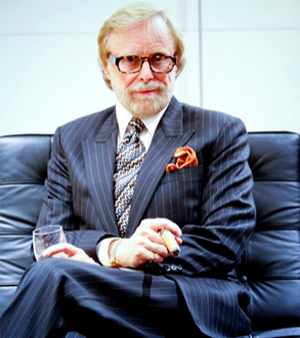Impeccable Workmanship
Workmanship,
abounds at different levels in every area from suits to cars to scuptures and more. Some are crude, others are a marvel of genius.
It’s the difference between an Aston Martin and a Jaguar. Both are great cars, but one has more expense in making it, painting it, etc.
Suits are the same.
Whether a jacket has a “hymo canvas” inside is what separates it from one that is put together in a fraction of the time and at a fraction of the expense. For centuries, the only way a suit was made was with a canvas interlining. It’s important to realize that simply because a jacket has a canvas hymo, doesn’t in itself mean that it is a good suit. Jackets that are “thrown together” in hours or a day, look good for about as long as it took to make them. Tailors in the Orient, particularly Hong Kong, were “admired”, but are really “notorius” for throwning cheaply made suits together just in time for their tourist customers to make it to their flight or cruise ship. The old adage, You get what you pay for, couldn’t be more true than in the making of a suit of clothes.
On the subject of Hong Kong, the irony is that while the tailors were paid by piecework, which gives them an incentive to throw a suit together as quickly as possibly, to get on to the next, they excelled in cutting, as much as they left to be desired in their workmanship. Their cutting skills, if properly “harnessed” with better training, and more pay for more hours or days of work, made them the logical choice for perfect fitting suits, rather than settling for well made suits in the US, England, Canada, England or Italy, that didn’t fit, due to the use of standard ready made patterns adopted by the tailors once they had access to mass production.
Through the 1960’s, and 70’s different “Brands”, like Oxford, Chester Barry, would distinguish themselves via a grading system Grades 1 through 6, 6 being the best. The higher Grade level indicated to the buyer what he was paying for; a level of workmanship that would give the garment a greater longer lasting look of quality that was built into the making of the jacket by a tailor who had both the techniques, the skill combined with double or triple the time put into the making of the jacket; thousands of close stitches fastening the cloth to the interlining combined with pressing, to “shape” the jacket to the formation of a man’s chest, the pitch of his shouilders. Custom tailors, of course, could and still can “personalize” the stitching and shaping and pressing the formation of the jacket to their client’s specific anatomy!
This is an intergal part of what has made Executive Tailored Clothes , long lasting, making our clothing look brand new for decades; due to the time and techniques spent in putting the jacket together! By taking our Italian tailor repeately to our workshop in Hong Kong, and paying him to share his skills and workmanship techniques with our Chinese tailors, we were able to capture the “best fitting” clothes, cut for each individual client, with the superior workmanship usually only found in Europe or America, but lacking in the proper fit, even with repeated fittings.
Meanwhile, in the 1970’s a alternative less expensive method of making suits and jackets by “fusing”; a heat transfer process that is now used in the making of some 95% of all suits and jackets sold in the stores. It has replaced all but the most expensive suits (approximately $2000 and up) which enables the distribution chain to funtion at the manufacturing, wholesaling and retail level, keeping the ultimate price less than if the suit was made with the more expensive labor.
It was only when the technology finally reached an acceptable level, (which meant no adverse bubbling, etc. in the early stages) that we make some of our casual jackets of “novelty” shirting and a few other jackets for a lighterweight softer construction. The process, under our Beverly Hills Custom Clothing label, does enable clients to enjoy the same perfect fit ouf our clothing, at a lesser expense.


